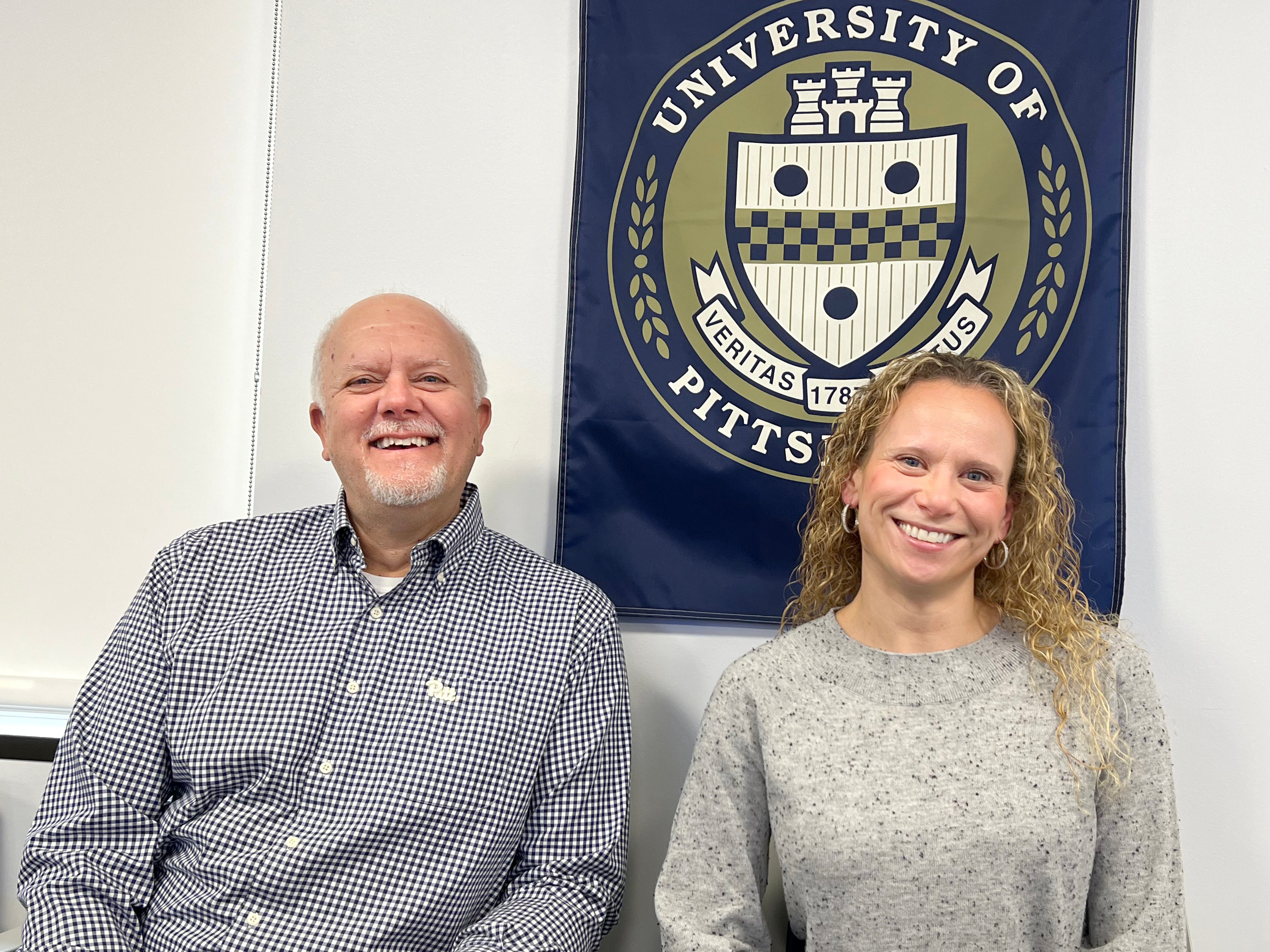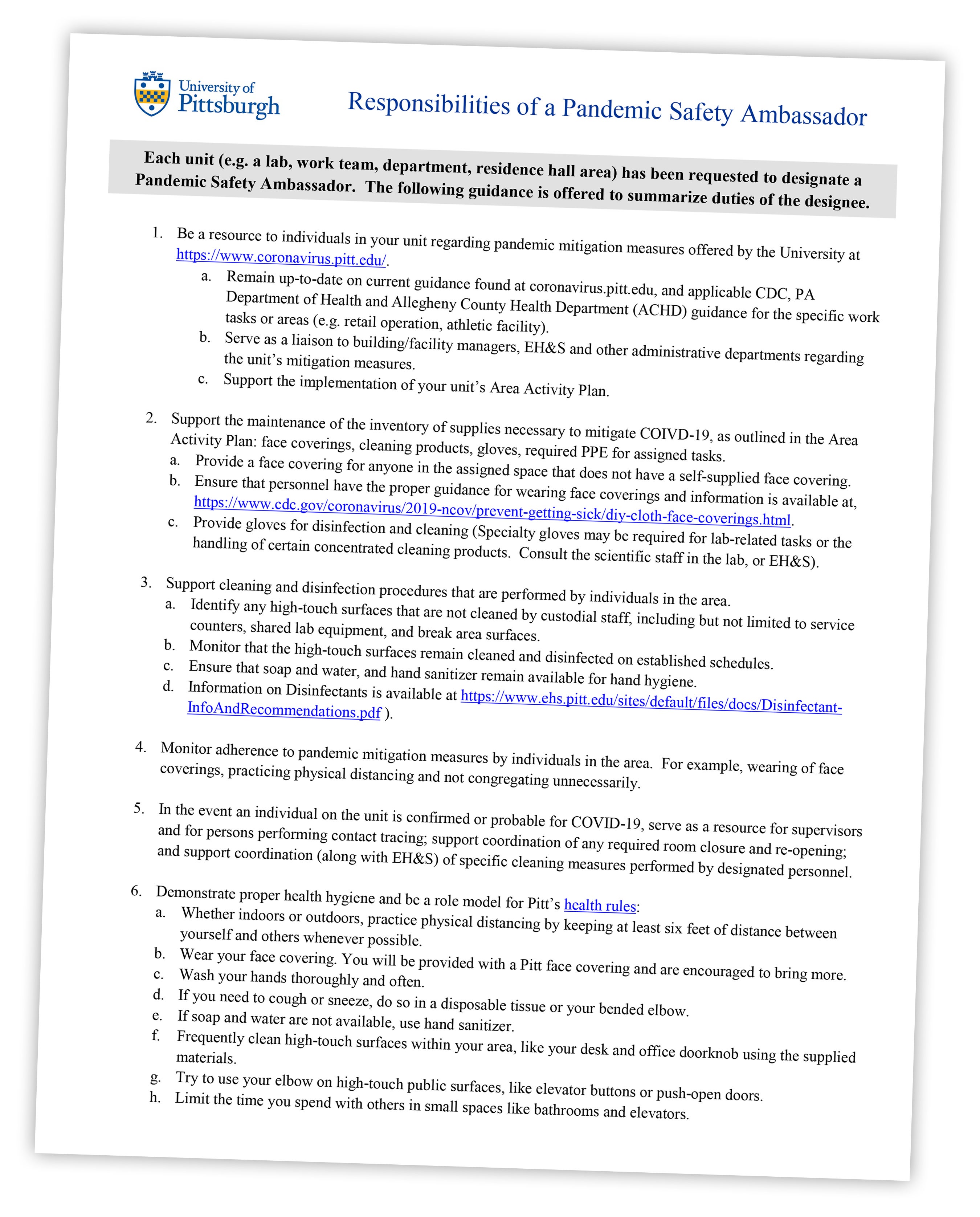Through monthly webinars, the Department of Environmental Health and Safety and its network of advocates continue to lead the discussion about campus safety and well-being.

Jay Frerotte and Heather Peffer. (University of Pittsburgh)
During the height of the COVID-19 pandemic — after cases of the virus began to skyrocket, the University of Pittsburgh went virtual, and the introduction of vaccines was topic of national debate — the school needed ways to keep its community informed with the most accurate guidance available at the time. The Environmental Health & Safety Department stepped in, and the Pandemic Safety Ambassador network was born.
More than two years later, COVID-19’s impact has lessened, valuable lessons were learned, and the program endured and evolved to address a host of safety topics at the Pittsburgh and regional campuses.
“It’s been a wonderful tool for us,” said Jay Frerotte, who leads EH&S as assistant vice chancellor for the Office of Public Safety and Emergency Management. “It’s been a conduit for people to get information and ask questions. But there was also this whole data component, where we had a cohort of 250 people representing so many areas of the University providing us with real-time data about what was happening in their respective area. Having that network to collect data was invaluable during the pandemic.”
Ultimately, the units, through their ambassador, had a voice in the conversation.
“In the beginning (of the pandemic), there was so much confusion and concern, especially at each individual department,” Frerotte said. “People didn’t know who to go to or where to get accurate information. With this network, they now had a point person to go to.”
Those point people -- or ambassadors – were able to relay concerns or questions from their respective unit to the other ambassadors and EH&S staff. From there, the EH&S staff, who also were involved in discussions with the Health Care Advisory Group, Resilience Steering Committee, and Pitt’s Covid Medical Response Office (CMRO), would then do its best to provide the latest information, resolve issues the ambassadors may have had, and find answers to questions that remained.
“It's that communication aspect that made it so beneficial,” said Doris Dick, associate director of administrative operations at the Office of Child Development. “I’m a strong believer in keeping people informed, and that people, when not knowing all the facts or seeing a more complete picture, they’ll make things up out of fear and anxiety. (EH&S) helped keep the people from panicking because they were keeping us and the community informed. So, they really minimized that.”
Frerotte and Heather Peffer, a laboratory safety specialist at EH&S, spearheaded the ambassador network after working on a similar program to provide information about lab safety in the two years prior to the pandemic’s onset.
“We saw that network and its success, and said, ‘Can we build on that? Can we use that model?’ ” Frerotte said.
Another positive effect of the pandemic? People learned how to meet virtually. Doing so was essential to EH&S meeting with its ambassadors for monthly webinars, which included a popular question-and-answer session. Having those important conversations helped the process, Peffer said.
“It worked really well. Sometimes, they’d present a question we hadn’t thought of, and they’d bring up questions that were specific to their units and their buildings,” she said. “They were [the boots on the ground]. They were living it, so they provided valuable feedback on the various guidance documents developed by the University.”
The clarity that Frerotte and Peffer provided to the rest of the group was appreciated.
“They were always willing to answer our questions, and not just the days of the sessions,” said Thomas Platt, associate dean for academic partnerships and professor and chair of the Department of Community Health Services and Rehabilitation Science. “I feel this put us all on the same page as far as Pitt's approach. There was much confusion during those days, CDC versus health systems versus politicians. This was a clear and concise message that shared where we stood as a community and how we could all do our best to get back to a new normal and stay safe.”

The original memo defined the roles of the safety ambassadors.
Deanna Jo Ferchak, a school nurse at Falk School, said the network “became essential” for the tight-knit K-8 school community and its families.
“It helped guide us through the University’s plans, expectations, and protocols during a time when there were so many questions and confusion about steps to take,” Ferchak said. “It gave us a clear path and foundation to build our response to COVID as a school community.”
Jamie Wincovitch, director at the University Child Development Center, said the program “aided us in making decisions that ultimately impacted the health and safety of the littlest ones on campus.”
The biggest challenge, Frerotte said, was keeping pace with a global pandemic that evolved quickly.
“Things were changing so rapidly. It was week-to-week, day-to-day,” he said. “The ambassadors met monthly, but sometimes, by the next meeting, what we had already discussed may have been obsolete. We were having trouble keeping up, but everyone was determined to do what was needed at the time.”
Since those tumultuous early days, COVID-19 has receded from the limelight as the most pressing issue facing the Pitt community, but the need to discuss safety has not diminished.
As EH&S leaders began to look forward beyond the pandemic, it conducted a survey of ambassadors in which 91% of the respondents said they wanted to continue participation in the network in some capacity. By March 2020, the ambassador network had its first non-COVID related webinar.
“We weren’t just going to fold it up,” Frerotte said. “It had become such a viable tool for safety information that we knew we were going to harness that energy.”
For ambassadors like Wincovitch, who remains a part of the network, there is “value in the regular meetings that reflect on a variety of topics surrounding health and safety at the University of Pittsburgh,” she said.
The monthly session now focuses on a range of issues, which include finding and obtaining EH&S services; what to do if you’re hurt at work; pedestrian safety; and ergonomics in the workplace. In October, the webinar was joined by the Emergency Management team, which introduced the group to UPitt Ready, the system that manages business and academic continuity if a crisis impacts the University’s ability to operate and recover.
“I believe the continuing role and involvement of the [ambassador network] should be to help establish this cohesive Continuity of Operations plan,” said Ferchak. “This plan will become a comprehensive living document and will provide information, resources, and contacts for each department to better plan for a future emergency event and help us be better prepared if faced with a future event such as the pandemic was.”
Peffer said the advocacy shown by the ambassadors has been commendable, a sentiment echoed by Frerotte.
“We owe them a great deal of thanks,” Peffer said. “They were concerned about the well-being of their co-workers. Even in the chats during monthly webinars, they have been so gracious, thanking us about the information we provided, or where they could go to get it. It makes me feel good just to know how we were able to help, but it also makes me feel good that we’re part of this community that is interested in helping each other.”
If you are a member of the faculty or staff at the University and would like to become a campus Safety Ambassador, please contact Heather Peffer directly at hmo1@pitt.edu or contact EH&S staff at 412-624-9505 or safety@pitt.edu. The most recent webinar is available at https://www.ehs.pitt.edu/pitt-safety-ambassadors.
